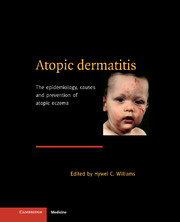Book contents
- Frontmatter
- Contents
- List of contributors
- Foreword Georg Rajka
- Preface
- Part I The nature of the problem
- Part II Descriptive studies which indicate the size of the problem
- Part III Analytical studies which point to causes of atopic dermatitis
- 8 Genetic epidemiology of atopic dermatitis
- 9 Fetal and perinatal origins of atopic dermatitis
- 10 Social factors and atopic dermatitis
- 11 The ‘old mother’ hypothesis
- 12 The possible role of environmental pollution in the development of atopic dermatitis
- 13 Atopic dermatitis in migrant populations
- 14 The role of inhalant allergens in atopic dermatitis
- 15 Dietary factors in established atopic dermatitis
- Part IV Intervention studies
- Part V Lessons from other fields of research
- Part VI Conclusions
- Additional information
- Index
- Plate section
11 - The ‘old mother’ hypothesis
from Part III - Analytical studies which point to causes of atopic dermatitis
Published online by Cambridge University Press: 17 August 2009
- Frontmatter
- Contents
- List of contributors
- Foreword Georg Rajka
- Preface
- Part I The nature of the problem
- Part II Descriptive studies which indicate the size of the problem
- Part III Analytical studies which point to causes of atopic dermatitis
- 8 Genetic epidemiology of atopic dermatitis
- 9 Fetal and perinatal origins of atopic dermatitis
- 10 Social factors and atopic dermatitis
- 11 The ‘old mother’ hypothesis
- 12 The possible role of environmental pollution in the development of atopic dermatitis
- 13 Atopic dermatitis in migrant populations
- 14 The role of inhalant allergens in atopic dermatitis
- 15 Dietary factors in established atopic dermatitis
- Part IV Intervention studies
- Part V Lessons from other fields of research
- Part VI Conclusions
- Additional information
- Index
- Plate section
Summary
Introduction
Industrialized countries have changed markedly in many ways during recent decades. This has led to changes and concerns regarding pollution, ozone depletion, change in food habits and indoor climate.
There are also significant changes for children in their increased education and later arrival at the job market. The changes starting in the 1960s have been quite remarkable, especially for women's social and organizational conditions. This has enabled women to achieve education and academic degrees quite comparable to what men have had for many years. Thus, the percentage of female doctors graduating from the University of Aarhus, Denmark, was 15% in 1965 and 52% in 1994.
A result of these changes has been that the age of first-time mothers has increased year by year. One reason for this, in many countries, has been the introduction of new kinds of birth control such as the contraceptive pill or access to legalized abortion. The use of such procedures reflects many underlying reasons such as women's desire for liberation and independence in otherwise male-dominated societies. This chapter looks at the relationship between maternal factors such as age of first-time mothers and gestational age, and the later development of atopic dermatitis.
Maternal factors and the increased prevalence of atopic dermatitis
Chapter 7 in this book, and many articles as reviewed elsewhere (Williams, 1992), describes how the prevalence of atopic dermatitis (AD) has increased significantly during recent decades in several European countries.
- Type
- Chapter
- Information
- Atopic DermatitisThe Epidemiology, Causes and Prevention of Atopic Eczema, pp. 148 - 154Publisher: Cambridge University PressPrint publication year: 2000



